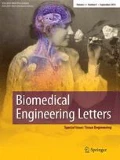Abstract
Purpose
This paper will introduce basic information on mitochondrial medicine and the direction of research. This paper will first introduce basic information on mitochondrial medicine and the direction of research. Then, it will delineate recent research on biomedical engineering methods and applications of mitochondrial medicine and discuss prospects of this research.
Methods
Recent research on mitochondrial medicine is based mostly on molecular biology. However, because energy production by mitochondria is linked closely to the macroscopic energy balance of the human body, the need for integrated research, based on systemic methods, is increasing.
Results
Mitochondrial medicine is expanding as a multidisciplinary field, and biomedical engineering applications are becoming more important. Using advances in optics or sensor technology, more engineering approaches should be effective in mitochondrial medicine.
Conclusions
Considering its broad scope and outcome as a diagnostic method, mitochondrial medicine will be a future paradigm of biomedical science, although it has numerous limitations at present.
Similar content being viewed by others
References
Kiberstis P, Roberts L. It’s not just the genes. Science. 2002; 296:685.
Wallace DC. Mitochondria & Chi. Genetics. 2008; 179:727–735.
Marengoni A, Rizzuto D, Wang HX, Winblad B, Fratiglioni L. Patterns of chronic multimorbidity in the elderly population. J Am Geriatr Soc. 2009; 57(2):225–230.
Jenks SF, Williams MV, Coleman EA. Rehospitalizations among patients in the medicare fee-for-service program. N Engl J Med. 2009; 360:1418–1428.
Scheffler IF. A century of mitochondria l research: achievements and perspectives. Mitochondrion. 2000; 1:3–31.
Race HI, Hermann RG, Martin W. Why have organelles retained genomes. Trends Genet. 1999; 15:364–370.
Harman D. The biologic clock: the mitochondria. J Am Geriatrics Soc. 1972; 20:145–147.
Liu X, Kim CN, Yang J, Jemmerson R, Wang X. Induction of apoptotic program in cell-free extracts: requirement for dATP and cytochrome c. Cell. 1996; 86(1):147–157.
Warburg O. The oxygen-transferring ferment of respiration. In nobel lectures, physiology or medicine 1922–1941, nobel lecture, 1931. Elsevier Publishing Company, Amsterdam, Holland, 1965 (and available online at the Nobel e-Museum).
Gatenby RA, Gillies RJ. Why do cancers have high aerobic glycolysis. Nat Rev Cancer. 2004; 4:891.
Turko IV, Murad F. Quantitative protein profiling in heart mitochondria from diabetic rats. J Biol Chem. 2003; 278(37): 35844–35849.
Bristow MR. Tumor necrosis factor-alpha and cardiomyopathy. Circ. 1998; 97(14):1340–1341.
Herrero A, Barja G. Localization of the site of oxygen radical generation inside complex I of heart and nonsynaptic brain mammalian mitochondria. J Bioenerg Biomembr. 2000; 32:609–615.
Park J, Lee SB, Lee S, Kim Y, Song S, Kim S, Bae E, Kim J, Shong M, Kim JM, Chung J. Mitochondrial dysfunction in drosophila PINK1 mutants is complemented by parkin. Nature. 2006; 441(7097):1157–1161.
Wallace DC. A mitochondrial paradigm of metabolic and degenerative diseases, aging, and cancer: a dawn for evolutionary medicine. Annu Rev Genet. 2005; 39:359–407.
Lee HK, Cho YM, Kwak SH, Lim S, Park KS, Shim EB. Mitochondrial dysfunction and metabolic syndrome-looking for environmental factors. Biochim Biophys Acta. 2010; 1800(3):282–289.
Kim JA, Lau EK, Pan L, De Blanco EJ. NF-kappaB inhibitors from Brucea javanica exhibiting intracellular effects on reactive oxygen species. Anticancer Res. 2010; 30(9):3295–300.
Castro-e-Silva T, Castro-e-Silva O, Kurachi C, Ferreira J, Zucoloto S, Bagnato VS. The use of light-emitting diodes to stimulate mitochondrial function and liver regeneration of partially hepatectomized rats. J Med Biol Res. 2007; 40(8):1065–1069.
Pastore D, Greco M, Passarella S. Specific helium-neon laser sensitivity of the purified cytochrome c oxidase. Int J Radiat Biol. 2000; 76(6):863–870.
Zungu IL, Hawkins Evans D, Abrahamse H. Mitochondrial responses of normal and injured human skin fibroblasts following low level laser irradiation-an in vitro study. Photochem Photobiol. 2009; 85(4):987–996.
Thorburn DR, Sugiana C, Salemi R, Kirby DM, Worgan L, Ohtake A, Ryan MT. Biochemical and molecular diagnosis of mitochondrial respiratory chain disorders. Biochim Biophys Acta. 2004; 1659(2–3):121–128.
Wong LJ. Comprehensive molecular diagnosis of mitochondrial disorders: qualitative and quantitative approach. Ann N Y Acad Sci. 2004; 1011:246–258.
Youn CH, Shim EB, Lim S, Cho YM, Hong HK, Choi YS, Park HD, Lee HK. A cooperative metabolic syndrome estimation with high precision sensing unit. IEEE Trans Biomed Eng. 2010 (in press).
Author information
Authors and Affiliations
Corresponding author
Rights and permissions
About this article
Cite this article
Shim, E.B., Youn, CH. Mitochondrial medicine and biomedical engineering. Biomed. Eng. Lett. 1, 21–26 (2011). https://doi.org/10.1007/s13534-011-0003-1
Received:
Revised:
Accepted:
Published:
Issue Date:
DOI: https://doi.org/10.1007/s13534-011-0003-1




